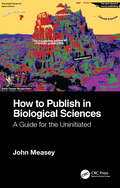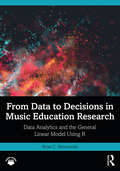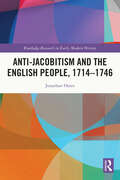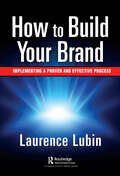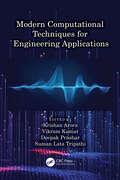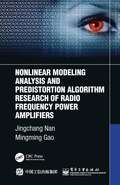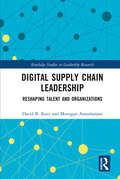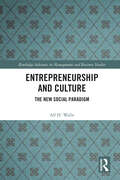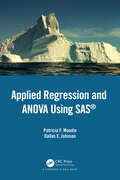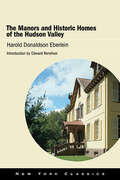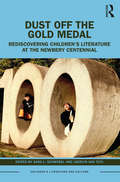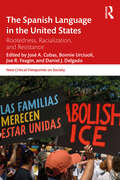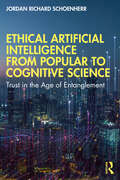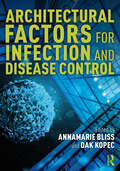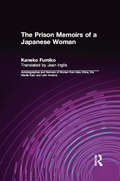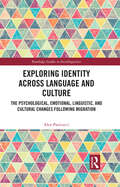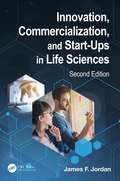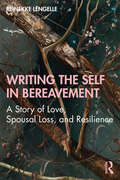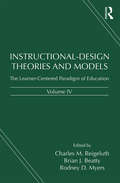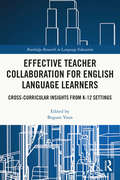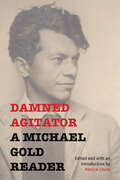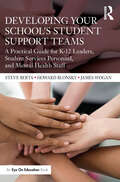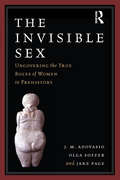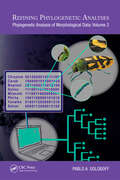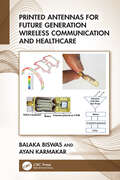- Table View
- List View
How to Publish in Biological Sciences: A Guide for the Uninitiated
by John MeaseyThis book is a guide specifically for Early Career Researchers on how to publish in the Biological Sciences, whether that be your first manuscript or if you’re already experienced – there’s something for everyone.Following on from How to Write a PhD in Biological Sciences: A Guide for the Uninitiated, it will guide you through taking your manuscript to publication in peer-reviewed journals and disseminating your research more broadly. It talks you through the peer-review process, including how to respond to reviewers’ comments, the meaning and importance of Impact Factors and how to get citations. It also explores the challenges in the academic community around Open Access and other debates, including transparency, overlay journals, paywalls, publication bias, predatory journals and the dangers of bullying.Whether you are a student just completing your studies, or a supervisor struggling with rejections, this book will provide the insider information you need to get ahead.
From Data to Decisions in Music Education Research: Data Analytics and the General Linear Model Using R
by Brian C. WesolowskiFrom Data to Decisions in Music Education Research provides a structured and hands-on approach to working with empirical data in the context of music education research. Using step-by-step tutorials with in-depth examples of music education data, this book draws upon concepts in data science and statistics to provide a comprehensive framework for working with a variety of data and solving data-driven problems.All of the skills presented here use the R programming language, a free, open-source statistical computing and graphics environment. Using R enables readers to refine their computational thinking abilities and data literacy skills while facilitating reproducibility, replication, and transparency of data analysis in the field. The book offers: A clear and comprehensive framework for thinking about data analysis processes in a music education context. An overview of common data structures and data types used in statistical programming and data analytics. Techniques for cleaning, preprocessing, manipulating, aggregating, and mining data in ways that facilitate organization and interpretation. Methods for summarizing and visualizing data to help identify structures, patterns, and trends within data sets. Detailed applications of descriptive, diagnostic, and predictive analytics processes. Step-by-step code for all concepts and analyses. Direct access to all data sets and R script files through the accompanying eResource. From Data to Decisions in Music Education Research offers a reference "cookbook" of code and programming recipes written with the graduate music education student in mind and breaks down data analysis processes and skills in an approachable fashion. It can be used across a wide range of graduate music education courses that rely on the application of empirical data analyses and will be useful to all music education scholars and professionals seeking to enhance their use of quantitative data.
Anti-Jacobitism and the English People, 1714–1746 (Routledge Research in Early Modern History)
by Jonathan OatesIn both 1715 and 1745 there was a major military challenge in Britain to the thrones of George I and George II, posed by Jacobite supporters of the exiled Stuart claimant. This book examines the responses of those loyal to the Hanoverian dynasty, whose efforts have been ignored or disparaged compared to the military perspective or that of the Jacobites.These efforts included those of the clergy who gave loyalist sermons, accompanied the volunteer forces against the Jacobites and even stood up to the Jacobite forces in person. The lords lieutenant organized militia and volunteer forces to support the status quo. Official bodies, such as the corporations, parishes, quarter sessions and sheriffs, organized events to celebrate loyalist occasions and dealt with local Jacobite sympathisers. The press, both national and regional, was uniformly loyal. Finally, both the middling and common people acted, often violently, against those thought to be hostile towards the status quo. The effectiveness of these bodies had limits, but was at times decisive, and showed that the dynasty was not without popular support in its hours of crisis.This volume is essential reading for all those interested in the Jacobite rebellions and the early English Georgian state, church and society.
How to Build Your Brand: Implementing a Proven and Effective Process
by Laurence LubinBrand Strategy is the most important marketing talent. A 2020 Gartner Survey of 400 CMO's cited Brand Strategy as the most needed skill, more valuable than analytics, UX, digital commerce. Previous books on the subject analyze the qualities and characteristics of well-regarded brands. What these books don't offer are the "how to's" of branding. This book empowers readers by teaching them the author's unique, time-tested Success Model, and step-by-step, repeatable method for successful brand building. After reading this insightful book, you will learn how to: Develop "big picture" insight that inspires big brand ideas Use imagery to understand the fundamental human values that give our life meaning as well as learn about the feelings that reveal our hopes and dreams. Develop highly motivating brand concepts that link to our values and aspirations. Create the tactical roadmap to implement the concepts. The author clearly shares the: Success Model that defines the world's most successful brands. Case studies that demonstrate the Model in action.Step-by-step method to implement the model. The evidence -- scientific and psychological --.that supports the model and method. Essentially, this book empowers readers to become skilled brand builders enabling them to succeed personally, socially, and professionally.For more information on this book, please visit: www.howtobuildyourbrand.net
Modern Computational Techniques for Engineering Applications
by Krishan Arora Vikram Kumar Deepak Prashar Suman Lata TripathiModern Computational Techniques for Engineering Applications presents recent computational techniques used in the advancement of modern grids with the integration of non-conventional energy sources like wind and solar energy. It covers data analytics tools for smart cities, smart towns, and smart computing for sustainable development.This book- Discusses the importance of renewable energy source applications wind turbines and solar panels for electrical grids. Presents optimization-based computing techniques like fuzzy logic, neural networks, and genetic algorithms that enhance the computational speed. Showcases cloud computing tools and methodologies such as cybersecurity testbeds and data security for better accuracy of data. Covers novel concepts on artificial neural networks, fuzzy systems, machine learning, and artificial intelligence techniques. Highlights application-based case studies including cloud computing, optimization methods, and the Industrial Internet of Things. The book comprehensively introduces modern computational techniques, starting from basic tools to highly advanced procedures, and their applications. It further highlights artificial neural networks, fuzzy systems, machine learning, and artificial intelligence techniques and how they form the basis for algorithms. It presents application-based case studies on cloud computing, optimization methods, blockchain technology, fog and edge computing, and the Industrial Internet of Things. It will be a valuable resource for senior undergraduates, graduate students, and academic researchers in diverse fields, including electrical engineering, electronics and communications engineering, and computer engineering.
Nonlinear Modeling Analysis and Predistortion Algorithm Research of Radio Frequency Power Amplifiers
by Jingchang Nan Mingming GaoThis book is a summary of a series of achievements made by the authors and colleagues in the areas of radio frequency power amplifier modeling (including neural Volterra series modeling, neural network modeling, X-parameter modeling), nonlinear analysis methods, and power amplifier predistortion technology over the past 10 years. The book is organized into ten chapters, which respectively describe an overview of research of power amplifier behavioral models and predistortion technology, nonlinear characteristics of power amplifiers, power amplifier behavioral models and the basis of nonlinear analysis, an overview of power amplifier predistortion, Volterra series modeling of power amplifiers, power amplifier modeling based on neural networks, power amplifier modeling with X-parameters, the modeling of other power amplifiers, nonlinear circuit analysis methods, and predistortion algorithms and applications.Blending theory with analysis, this book will provide researchers and RF/microwave engineering students with a valuable resource.
Digital Supply Chain Leadership: Reshaping Talent and Organizations (Routledge Studies in Leadership Research)
by David Kurz Murugan AnandarajanStrong leadership is necessary to drive the transformational change required to build and apply digital capabilities across organizations. Digital transformation in the supply chain is a leadership problem first and foremost. This book draws out some of the key digital business strategies supply chain leaders must become familiar with as they take on the responsibilities of leading transformations within their firms.The central rationale of the book is to establish a clear business case for the performance shifts and opportunities of the Digital Supply Chain. The benefits of a digital supply chain for firms can be summarized as uniquely reducing the amount of trade-off between costs and customer satisfaction. The challenges, complexity, and management involved in transforming to a digital supply chain have slowed many firms in their implementation. The key to unlocking this value and advantage is a new, robust, and digitally aware supply chain leadership mindset. It will provide readers with a practical Digital Supply Chain Leadership Road Map that will accelerate actions in technology, analytics, talent and business models. The road map to digital transformation will step the reader through these critical dimensions and illustrate how they can support their own organizational transformation by developing greater levels of maturity. This book will be most valued by supply chain leaders in medium to large scale organizations, as well as consultants and academics interested in digital business and supply chain transformation. The book will also be valuable for students studying digital transformation, supply chain, and operations.
Entrepreneurship and Culture: The New Social Paradigm (ISSN)
by Alf H. WalleThe classic and dominant paradigm of entrepreneurship emphasizes the relatively universal and homogeneous responses of a small, but influential, minority as they make unique and breakthrough contributions. Entrepreneurs are often viewed as inspired individualists who possess the courage to "go against the grain" as they risk it all to pursue an impassioned vision. According to Joseph Schumpeter and those who build upon his seminal perspectives, such entrepreneurial individuals pursue a path of "creative destruction" that paves the way towards true and innovative progress. Today, state of the art research is tempering and transcending this classic vision by acknowledging a wider array of cultural, psychological, and environmental contexts, influences, and responses. This monograph contributes to this research stream by viewing entrepreneurs within a cultural perspective and advocating viewing entrepreneurship in "culturally competent" ways. Presenting these perspectives in a short and circumscribed volume provides an elegant and influential means of disseminating these important perspectives. Entrepreneurship and Culture expands beyond popular and conventional views of entrepreneurship and provides readers with alternative perspectives in even-handed ways. It shows the latest state of knowledge on the topic and will be of value both to advanced students, and to academics and practitioners in the fields of entrepreneurship, international business, leadership and organizational studies. Beyond the business school, this book will also be of interest to anthropology, economic development, and indigenous studies scholars.
Applied Regression and ANOVA Using SAS
by Patricia F. Moodie Dallas E. JohnsonApplied Regression and ANOVA Using SAS® has been written specifically for non-statisticians and applied statisticians who are primarily interested in what their data are revealing. Interpretation of results are key throughout this intermediate-level applied statistics book. The authors introduce each method by discussing its characteristic features, reasons for its use, and its underlying assumptions. They then guide readers in applying each method by suggesting a step-by-step approach while providing annotated SAS programs to implement these steps.Those unfamiliar with SAS software will find this book helpful as SAS programming basics are covered in the first chapter. Subsequent chapters give programming details on a need-to-know basis. Experienced as well as entry-level SAS users will find the book useful in applying linear regression and ANOVA methods, as explanations of SAS statements and options chosen for specific methods are provided.Features:•Statistical concepts presented in words without matrix algebra and calculus•Numerous SAS programs, including examples which require minimum programming effort to produce high resolution publication-ready graphics•Practical advice on interpreting results in light of relatively recent views on threshold p-values, multiple testing, simultaneous confidence intervals, confounding adjustment, bootstrapping, and predictor variable selection•Suggestions of alternative approaches when a method’s ideal inference conditions are unreasonable for one’s dataThis book is invaluable for non-statisticians and applied statisticians who analyze and interpret real-world data. It could be used in a graduate level course for non-statistical disciplines as well as in an applied undergraduate course in statistics or biostatistics.
The Manors and Historic Homes of the Hudson Valley (New York Classics)
by Harold Donaldson EberleinHarold Donaldson Eberlein's The Manors and Historic Homes of the Hudson Valley has been considered an essential and elegant resource ever since its first publication by J.B. Lippincott in 1924. Profusely illustrated with drawings, classic prints, and photographs (many of the latter taken by the author himself), the book not only discusses the architecture and beauty of more than thirty-five historically relevant estates and homesteads, but also contextualizes their varied histories amid key social and political disruptions, ranging from the rise of the Dutch through to the American Revolution and the heyday of the patroonships overseen by such families as the Livingstons, the Van Rensselaers, and the Van Cortlandts. Eberlein saw the old manors and historic homes of the Hudson Valley as vital signposts to that history of the region— a history "inseparably bound up with the old houses that stand upon both banks of the river, and [a history which] without them … would lose its dramatic force and become a dull, dead abstraction." This new edition features an introduction by historian Ed Renehan who sets the work in the context of its time, and many new photographs. This book is an indispensable resources for those interested in New York state history and the stories behind some of its best-loved homes.
Dust Off the Gold Medal: Rediscovering Children’s Literature at the Newbery Centennial (Children's Literature and Culture)
by Sara L. SchwebelThe oldest and most prestigious children’s literature award, the Newbery Medal has since 1922 been granted annually by the American Library Association to the children’s book it deems "most distinguished." Medal books enjoy an outsized influence on American children’s literature, figuring perennially on publishers’ lists, on library and bookstore shelves, and in school curricula. As such, they offer a compelling window into the history of US children’s literature and publishing, as well as into changing societal attitudes about which books are "best" for America’s schoolchildren. Yet literary scholars have disproportionately ignored the Medal winners in their research. This volume provides a critically- and historically-grounded scholarly analysis of representative but understudied Newbery Medal books from the 1920s through the 2010s, interrogating the disjunction between the books’ omnipresence and influence, on the one hand, and the critical silence surrounding them, on the other. Dust Off the Gold Medal makes a case for closing these scholarly gaps by revealing neglected texts’ insights into the politics of children’s literature prizing and by demonstrating how neglected titles illuminate critical debates currently central to the field of children’s literature. In particular, the essays shed light on the hidden elements of diversity apparent in the neglected Newbery canon while illustrating how the books respond—sometimes in quite subtle ways—to contemporaneous concerns around race, class, gender, disability, nationalism, and globalism.
The Spanish Language in the United States: Rootedness, Racialization, and Resistance (New Critical Viewpoints on Society)
by José A. CobasThe Spanish Language in the United States addresses the rootedness of Spanish in the United States, its racialization, and Spanish speakers’ resistance against racialization. This novel approach challenges the "foreigner" status of Spanish and shows that racialization victims do not take their oppression meekly. It traces the rootedness of Spanish since the 1500s, when the Spanish empire began the settlement of the new land, till today, when 39 million U.S. Latinos speak Spanish at home. Authors show how whites categorize Spanish speaking in ways that denigrate the non-standard language habits of Spanish speakers—including in schools—highlighting ways of overcoming racism.
Ethical Artificial Intelligence from Popular to Cognitive Science: Trust in the Age of Entanglement
by Jordan Richard SchoenherrThis book offers a unique interdisciplinary perspective on the ethics of 'artificial intelligence' – autonomous, intelligent, (and connected) systems, or AISs, applying principles of social cognition to understand the social and ethical issues associated with the creation, adoption, and implementation of AISs.As humans become entangled in sociotechnical systems defined by human and artificial agents, there is a pressing need to understand how trust is created, used, and abused. Compounding the difficulty in answering these questions, stakeholders directly or indirectly affected by these systems differ in their motivations, understanding, and values. This volume provides a comprehensive resource to help stakeholders understand ethical issues of designing and implementing AISs using an ethical sensemaking approach. Starting with the general technical affordances of AIS, Dr. Jordan Richard Schoenherr considers the features of system design relating data integrity, selection and interpretation of algorithms, and the evolution processes that drive AISs innovation as a sociotechnological system. The poles of technophobia (algorithmic aversion) and technophilia (algorithmic preference) in the public perception of AISs are then described and considered against existing evidence, including issues ranging from the displacement and re-education needs of the human workforce, the impact of use of technology on interpersonal accord, and surveillance and cybersecurity. Ethical frameworks that provide tools for evaluating the values and outcomes of AISs are then reviewed, and how they can be aligned with ethical sensemaking processes identified by psychological science is explored. Finally, these disparate threads are brought together in a design framework.Also including sections on policies and guideline, gaming and social media, and Eastern philosophical frameworks, this is fascinating reading for students and academics in psychology, computer science, philosophy, and related areas, as well as professionals such as policy makers and those working with AI systems.
Architectural Factors for Infection and Disease Control
by AnnaMarie Bliss Dak KopecThis edited collection explores disease transmission and the ways that the designed environment has promoted or limited its spread. It discusses the many design factors that can be used for infection and disease control through lenses of history, public health, building technology, design, and education.This book calls on designers to consider the role of the built environment as the primary source of bacterial, viral, and fungal transfers through fomites, ventilation systems, and overcrowding and spatial organization. Through 19 original contributions, it provides an array of perspectives to understand how the designed environment may offer a reprieve from disease. The authors build a historical foundation of infection and disease, using examples ranging from lazarettos to leprosy centers to show how the ability to control infection and disease has long been a concern for humanity. The book goes on to discuss disease propagation, putting forth a variety of ideas to control the transmission of pathogens, including environmental design strategies, pedestrian dynamics, and open space. Its final chapters serve as a prospective way forward, focusing on COVID-19 and the built environment in a post-pandemic world.Written for students and academics of architecture, design, and urban planning, this book ignites creative action on the ways to design our built environment differently and more holistically.Please note that research on COVID-19 has exponentially grown since this volume was written in October 2020. References cited reflect the evolving nature of research studies at that time.
The Prison Memoirs of a Japanese Woman
by Kaneko Fumiko Mikiso Hane Jean InglisKaneko Fumiko (1903-1926) wrote this memoir while in prison after being convicted of plotting to assassinate the Japanese emperor. Despite an early life of misery, deprivation, and hardship, she grew up to be a strong and independent young woman. When she moved to Tokyo in 1920, she gravitated to left-wing groups and eventually joined with the Korean nihilist Pak Yeol to form a two-person nihilist organization. Two days after the Great Tokyo Earthquake, in a general wave of anti-leftist and anti-Korean hysteria, the authorities arrested the pair and charged them with high treason. Defiant to the end (she hanged herself in prison on July 23, 1926), Kaneko Fumiko wrote this memoir as an indictment of the society that oppressed her, the family that abused and neglected her, and the imperial system that drove her to her death.
Exploring Identity Across Language and Culture: The Psychological, Emotional, Linguistic, and Cultural Changes Following Migration (Routledge Studies in Sociolinguistics)
by Alex PanicacciThis book explores the ways in which migrants’ experience in today’s multilingual and multicultural society informs language use and processing, behavioural patterns, and perceptions of self-identity.Drawing on survey data from hundreds of Italian migrants living in English- speaking countries, in conjunction with more focused interviews, this volume unpacks reciprocal influences between linguistic, cultural, and psychological variables to shed light on how migrants emotionally engage with the local and heritage dimensions across public and private spaces. Visualising the impact of a constant shifting of linguistic and cultural practices can enhance our understanding of migration experiences, foreign language acquisition, language processing and socialisation, inclusion, integration, social dynamics, acculturation tendencies, and cross-cultural communication patterns.Overall, this book appeals to students and scholars interested in gaining nuanced insights into the linguistic, cultural, and psychological underpinnings of migration experiences in such disciplines as sociolinguistics, cultural studies, and social psychology.
Innovation, Commercialization, and Start-Ups in Life Sciences
by James F. JordanInnovation is a translation of a new method, idea, or product into reality and profit. It is a process of connected steps that accumulates into a brand reputation required for success. Unlike Fortune 500 companies, whose projects are self-funded, a start-up must simultaneously have a value proposition that attracts a customer (for revenue), investors (for capital), and acquirers (for a liquidity event or IPO). A high percentage of start-ups fail before attaining positive cashflow, due to a variety of reasons that are detailed in this book.Avoiding the pitfalls and wrong turns are the goals of this book. Innovation, Commercialization, and Start-Ups in Life Sciences details the methodologies necessary to create a successful life science start-up from initiation to exit. Written by an expert who has worked with more nearly 500 life science start-ups, this book discusses specific processes and investor milestones that must be navigated to align customer, funder, and acquirer needs. Successful commercialization requires attention to multiple constituents, such as investors, regulators, and customers. Investors require liquidity for their return, which is achieved through selling their stock in a public or private sale. The reader will gain an appreciation for the necessary data, partnerships, and skills needed to create a competitive and sustainable company. The author discusses such specific issues as customer problems, demonstrating sales access, and ensuring intellectual property is impervious to competitive advancement. This book is intended to be suitable for entrepreneurs, venture capitalists, and investors in both business and academic settings. These organizations have specific departments, such as R&D, operations, business development, legal, regulatory, and marketing, that would also benefit from this book.FEATURES Focuses specifically on life science start-ups Examines how to determine a company valuation and future "fundable milestones" Explores how to align regulatory and clinical strategies Discusses intellectual property derived from a university or individual through formation to exit. Reviews how start‐ups must simultaneously meet the needs of multiple constituencies at once: investors, regulators, customers and exit candidates James F. Jordan is an author, consultant, and speaker. He is a Distinguished Service Professor of Healthcare & Biotechnology Management, a former Fortune 100 executive, and a managing director of a venture fund.Access the Support Material: https://healthcaredata.center/ Cover design by Sarah Mailhott.
Writing the Self in Bereavement: A Story of Love, Spousal Loss, and Resilience (ISSN)
by Reinekke LengelleWinner, ICQI 2022 Outstanding Qualitative Book AwardIn Writing the Self in Bereavement: A Story of Love, Spousal Loss, and Resilience, Reinekke Lengelle uses her abilities as a researcher, poet, and professor of therapeutic writing to tell a heartfelt and fearless story about her grief after the death of her spouse and the year and a half following his diagnosis, illness, and passing. This book powerfully demonstrates that writing can be a companion in bereavement. It uses and explains the latest research on coming to terms with spousal loss without being prescriptive. Integrated with this contemporary research are stories, poetry, and reflections on writing as a therapeutic process. The author unflinchingly explores a number of themes that are underrepresented in existing resources: how one deals with anger associated with loss, what a healthy response might be to unfinished business with the deceased, continuing conversations with the beloved (even for agnostics and atheists), ongoing sexual desire, and secondary losses. As a rare book where an author successfully combines a personal story, heart-rending poetry, up-to-date research on grief, and an evocative exploration of taboo topics in the context of widowhood, Writing the Self in Bereavement is uniquely valuable for those grieving a spouse or other loved one, those supporting others in bereavement, and those interested in the healing power of poetry and life writing. Researchers on death and dying, grief counsellors, and autoethnographers will also benefit from reading this resonant resource on love and loss.
Instructional-Design Theories and Models, Volume IV: The Learner-Centered Paradigm of Education
by Charles M. Reigeluth, Brian J. Beatty, and Rodney D. MyersInstructional-Design Theories and Models, Volume IV provides a research-based description of the current state of instructional theory for the learner-centered paradigm of education, as well as a clear indication of how different theories and models interrelate. Significant changes have occurred in learning and instructional theory since the publication of Volume III, including advances in brain-based learning, learning sciences, information technologies, internet-based communication, a concern for customizing the student experience to maximize effectiveness, and scaling instructional environments to maximize efficiency.In order to complement the themes of Volume I (commonality and complementarity among theories of instruction), Volume II (diversity of theories) and Volume III (building a common knowledge base), the theme of Volume IV is shifting the paradigm of instruction from teacher-centered to learner-centered and integrating design theories of instruction, assessment, and curriculum. Chapters in Volume IV are collected into three primary sections: a comprehensive view of the learner-centered paradigm of education and training, elaborations on parts of that view for a variety of K-12 and higher education settings, and theories that address ways to move toward the learner-centered paradigm within the teacher-centered paradigm. Instructional-Design Theories and Models, Volume IV is an essential book for anyone interested in exploring more powerful ways of fostering human learning and development and thinking creatively about ways to best meet the needs of learners in all kinds of learning contexts.
Effective Teacher Collaboration for English Language Learners: Cross-Curricular Insights from K-12 Settings (Routledge Research in Language Education)
by Bogum YoonThis volume explores the value of teacher collaboration in meeting the needs of diverse English language learners (ELLs). A range of research-based chapters demonstrate examples of effective collaboration between English language specialists and content area teachers and offer recommendations for collaborative practice.Foregrounding the ways in which teacher collaboration can better support the needs of ELLs in elementary, middle, and high school classrooms, this volume provides evidence-based insights and suggestions to underpin effective teacher collaboration across the curriculum. Through case study examples, readers can understand common challenges and pitfalls, as well as best practices and how to apply teacher collaboration in real classroom settings. Research studies in subject areas including mathematics, science, and English language arts provide a basis for practical, evidence-based recommendations to engender mutual trust, teacher agency, and the development of shared goals to enhance instruction for ELLs’ achievement.This book provides educators with new insights from empirical studies, and is vital reading for researchers, scholars, teachers, and teacher educators who are aware of the importance of collaboration for student success. Those involved in ESL, bilingual, and dual language programs may be particularly interested in this volume.
Damned Agitator: A Michael Gold Reader
by Michael Gold"Is it time to release Michael Gold from his personal gulag to range free in the pastures of 20th-century American literature?" — Jim Hoberman, The NationThis definitive collection of fiction, drama, poetry, and journalism, edited by the author of the award-winning biography Michael Gold: The People's Writer, shows why Michael Gold was once the most famous radical writer in America and why his pro-democracy message still matters. From 1914 to 1966, Gold produced a body of literature best defined as "the direct expression of a man who is angry about something"—the injustices of American society. From his early support for radical leaders like John Reed and solidarity with impoverished immigrants and exploited workers, to his determined support for the Civil Rights movement and opposition to the Vietnam War, Damned Agitator shows how Gold directed his righteous indignation to advocate for those who were least able to advocate for themselves. This collection is the first to include the full range of Gold's writings, from poetry, fiction, and drama to literary criticism, personal memoir, and social commentary. At a time when democracy is threatened worldwide, Michael Gold is freshly relevant to a new generation. Though his legacy has been largely erased, this book recovers the deep political passions of the "damned agitator."
Developing Your School’s Student Support Teams: A Practical Guide for K-12 Leaders, Student Services Personnel, and Mental Health Staff
by Steve Berta Howard Blonsky James WoganDeveloping Your School’s Student Support Teams is a practical manual for schools seeking to establish and sustain coordinated teams in support of students’ social, emotional and behavioral health. Every day, students struggle with a range of issues, including traumas, that complicate their learning, engagement, and overall well-being. School psychologists, counselors, social workers and nurses are employed in many school districts, but their schedules often make it difficult to collaborate effectively in developing and implementing comprehensive intervention plans. This book promotes teamwork throughout schools by exploring how interdependent practitioners can come together at the appropriate levels and times to help coordinate school and community resources. This "filtering" process will guide K-12 leaders and service professionals toward systems and decision-making that enable long-term student supports, accurate identification of systemic learning barriers, improved school culture and climate, attention to diverse populations, and more. With these proactive teamwork strategies, school staff will be better prepared to share workload and accountability and to identify and build upon the existing strengths and supports of every student.
The Invisible Sex: Uncovering the True Roles of Women in Prehistory
by J. M. Adovasio Olga Soffer Jake PageShaped by cartoons and museum dioramas, our vision of Paleolithic times tends to feature fur-clad male hunters fearlessly attacking mammoths while timid women hover fearfully behind a boulder. Recent archaeological research has shown that this vision bears little relation to reality. J. M. Adovasio and Olga Soffer, two of the world's leading experts on perishable artifacts such as basketry, cordage, and weaving, present an exciting new look at prehistory. With science writer Jake Page, they argue that women invented all kinds of critical materials, including the clothing necessary for life in colder climates, the ropes used to make rafts that enabled long-distance travel by water, and nets used for communal hunting. Even more important, women played a central role in the development of language and social life—in short, in our becoming human. In this eye-opening book, a new story about women in prehistory emerges with provocative implications for our assumptions about gender today.
Refining Phylogenetic Analyses: Phylogenetic Analysis of Morphological Data: Volume 2 (Species and Systematics)
by Pablo A. GoloboffThis volume discusses the aspects of a phylogenetic analysis that go beyond basic calculation of most parsimonious trees. Practical application of all principles discussed is illustrated by reference to TNT, a freely available software package that can perform all the steps needed in a phylogenetic analysis. The first problem considered is how to summarize and compare multiple trees (including identification and handling wildcard taxa). Evaluation of the strength of support for groups, another critical component of any phylogenetic analysis, is given careful consideration. The different interpretations of measures of support are discussed and connected with alternative implementations. The book reviews rationales for estimating character reliability on the basis of homoplasy, with particular attention to morphological characters. The main methods for character weighting and their practical implementation, several of them unique to TNT, are discussed ad libitum. Also unique to TNT is the ability to directly analyze morphometric data (including landmarks), on the same footing as discrete characters. Finally, the scripting language of TNT is introduced. With scripting, it is possible to "program" TNT to create personalized routines and automate complex calculations, taking analyses to the next level and allowing exploration of new methods and ideas.Key Features Discusses the treatment of ambiguity in phylogenetic analyses in depth, for summarizing results or comparing trees Reviews literature on arguments and methods for weighting morphological characters and their practical application Describes theory and application of methods for evaluating strength of group support, based on either resampling or comparisons with suboptimal trees Discusses the use of morphometric characters in phylogenetic analysis Presents extensive information on commands and options of the TNT computer program, including the use and creation of scripts
Printed Antennas for Future Generation Wireless Communication and Healthcare
by Balaka Biswas Ayan KarmakarThis proposed book focuses on the design and development of printed antennas along with modeling aspects for multifaceted applications. It further investigates imperfections in the manufacturing processes and assembly operation during the testing/characterization of printed antennas.This text- Discusses in a comprehensive manner the design and development aspects of printed antennas. Provides fractal engineering aspects for miniaturization and wideband characteristics of the low-profile antenna with high performances. Covers high gain printed antenna for Terahertz application. Showcases electrical modeling of smart antennas. Pedagogical features such as review questions based on practical experiences are included at the end of each chapter. The book comprehensively discusses fractal engineering in printed antennas for miniaturization and enhancement of performance factors. It further covers the modeling of electrically small antennas, circuit modeling, modeling of factual-based Ultra-Wide Band antennas, and modeling of reconfigurable micro-electromechanical system-based patch antennas. The book highlights performance metrics of multiple-input-multiple-output antennas. It will serve as an ideal reference text for senior undergraduate, graduate students, and academic researchers in fields including electrical engineering, electronics, communications engineering, and computer engineering.
